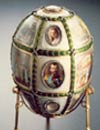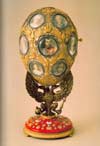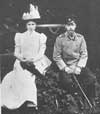HISTORY OF FABERGE
When Trans-Siberian railroad was completed it connected the entire Russian
empire from one end to the other. It was a symbolic event. But the railroad
could not solve all of Russia’s problems. By 1905, the economy was at
all time low. Factory workers went on strike and people took it to the
streets demanding better wages and living conditions. But Nicholas II,
Tsar of Russia, did nothing to help them.
Nicholas II was very passive and idealistic person. Idealistic in the sense that he expected everything to be taken care of by what he called "will of God". During his entire reign, he never had a thought of how to do what he was doing. He referred everything to the will of God. Imperial family was totally self-centered, so much so that they seemed to be really quite unaware what was going on around them.
Amid the chaos, Faberge’s ties to the palace grew stronger. The Royal Family took pictures of each other – Faberge made picture frames; Nicholas II smoked – Faberge made cigarette cases; and of course the magnificent Imperial Eggs continued to arrive every Easter morning.
As a husband and father, Nicholas II was without any hesitancy deeply loving, very committed, very gentle, very fun-loving man and children adored him, his wife adored him. And every one who new him on private level loved him.
Public perception, however, was another matter. Nicholas II proved
to be a weak and misguided monarch. The discontent of the working class
grew stronger. He refused to address their grievances. Revolutionary
groups were meeting behind closed doors. Nicholas II ignored their existence.
Instead, he took center stage along Russia’s elite to celebrate the
jubilee of country’s three hundred year old Romanov dynasty.

Faberge embraced the spirit of the occasion by designing the Tercentenary Egg. This egg is decorated with 18 miniature portraits that depict rulers of the Romanov dynasty, from Mikhail Fedorovitch (1613) to Nicholas II. Faberge hoped to raise moral and rally support for the Imperial Family by making hundreds of items to commemorate the anniversary.
In 1914, Russia with all its internal problems, found herself in the
middle of World War I. The war was Nicholas’s reason for being. In his
own mind, he loved soldiering life and ultimately he went and played
soldiers at the front line. Empress Alexandra, during the war, became
a nurse, red-cross trained nurse, and assisted in all sorts of surgical
operations. She was as eager as the Tsar was to serve in the situation.

But Nicholas II was not a leader. His incompetence, combined with Russia’s social catastrophe and World War I, created a fertilized breeding ground for revolution. Russia’s involvement in World War I was the direct encouragement for the revolution. By the third year of war many Russians have died, many people have been displaced, many industries and factories ware disrupted, the economy was in chaos, the Emperor and his family were regarded as out of content. The entire system seemed to be broken down – there was no place to go but down.
By 1916, the majority of Russia’s population no longer supported the Tsar. Bolshevik revolutionaries were forming to overthrow the government in favor of communism. Everything was about to change.
